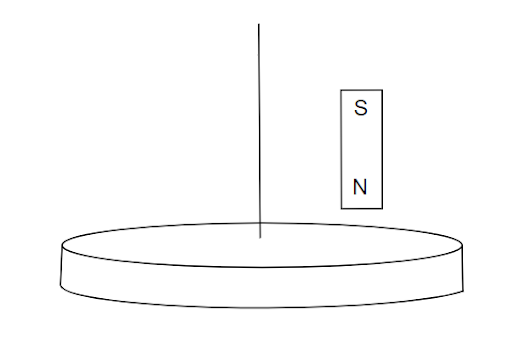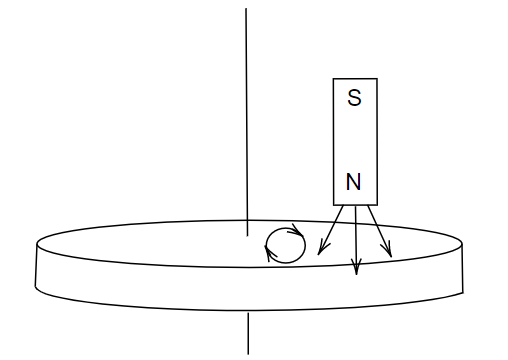
A light disc made of aluminium (a nonmagnetic material) is kept horizontally and is free to rotate about its axis as shown in the figure. A strong magnet is held vertically at a point above the disc away from its axis. On revolving the magnet about the axis of the disc, what happens to the disc? (The figure is schematic and not drawn to scale).

A. Rotate in the direction opposite to the direction of the magnet’s motion
B. Rotate in the same direction as the direction of the magnet’s motion
C. Not rotate and its temperature will remain unchanged
D. Not rotate but its temperature will slowly rise
Answer
224.7k+ views
Hint:Before we proceed with the problem, it is important to know about the Lenz law. The emf will be induced Whenever there is a magnetic flux linked with the coil and the direction of induced emf opposes the change in magnetic flux known as Lenz law.
Complete step by step solution:
Now we can solve the problem step by step as follows.

Image: An aluminium disc with the magnet held above it.
The aluminium disc and the magnet area as shown in the figure. Now, if we start moving the magnet about the axis of the disc, the number of magnetic field lines changes, that is the magnetic field line decreases. Here considering a small area of the disc where the magnetic field line passes. The magnetic flux is defined as the number of field lines passing per unit area, whereas flux and magnetic field are directly proportional to each other, the magnetic field decreases, and the flux also decreases.
Based on Lenz’s law, the disc also tries to move in the same direction as the magnet. On the underside of the disc, due to the movement of the magnet, there is a reduction in flux. This flux change causes the production of eddy currents which leads to the generation of heat. These currents are such that they oppose the relative motion of the disc. So, the disc will rotate in the direction of the rotation of the magnet.
Hence, Option B is the correct answer
Note:Lenz's law will be helpful to understand the concept of stored magnetic energy in an inductor. It is also used in microphones, AC generators, etc.
Complete step by step solution:
Now we can solve the problem step by step as follows.

Image: An aluminium disc with the magnet held above it.
The aluminium disc and the magnet area as shown in the figure. Now, if we start moving the magnet about the axis of the disc, the number of magnetic field lines changes, that is the magnetic field line decreases. Here considering a small area of the disc where the magnetic field line passes. The magnetic flux is defined as the number of field lines passing per unit area, whereas flux and magnetic field are directly proportional to each other, the magnetic field decreases, and the flux also decreases.
Based on Lenz’s law, the disc also tries to move in the same direction as the magnet. On the underside of the disc, due to the movement of the magnet, there is a reduction in flux. This flux change causes the production of eddy currents which leads to the generation of heat. These currents are such that they oppose the relative motion of the disc. So, the disc will rotate in the direction of the rotation of the magnet.
Hence, Option B is the correct answer
Note:Lenz's law will be helpful to understand the concept of stored magnetic energy in an inductor. It is also used in microphones, AC generators, etc.
Recently Updated Pages
JEE Main 2025-26 Experimental Skills Mock Test – Free Practice

JEE Main 2025-26: Magnetic Effects of Current & Magnetism Mock Test

JEE Main 2025-26 Atoms and Nuclei Mock Test – Free Practice Online

JEE Main Mock Test 2025-26: Optics Chapter Practice Online

The work done in slowly moving an electron of charge class 12 physics JEE_Main

The value of the resistor RS needed in the DC voltage class 12 physics JEE_Main

Trending doubts
JEE Main 2026: City Intimation Slip and Exam Dates Released, Application Form Closed, Syllabus & Eligibility

JEE Main 2026 Application Login: Direct Link, Registration, Form Fill, and Steps

Understanding the Angle of Deviation in a Prism

Hybridisation in Chemistry – Concept, Types & Applications

How to Convert a Galvanometer into an Ammeter or Voltmeter

Ideal and Non-Ideal Solutions Explained for Class 12 Chemistry

Other Pages
JEE Advanced Marks vs Ranks 2025: Understanding Category-wise Qualifying Marks and Previous Year Cut-offs

JEE Advanced 2026 - Exam Date (Released), Syllabus, Registration, Eligibility, Preparation, and More

JEE Advanced 2026 - Exam Date (Released), Syllabus, Registration, Eligibility, Preparation, and More

Dual Nature of Radiation and Matter Class 12 Physics Chapter 11 CBSE Notes - 2025-26

Understanding Atomic Structure for Beginners

Understanding Electromagnetic Waves and Their Importance




